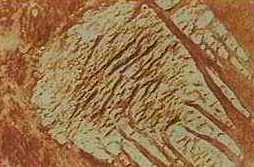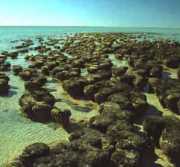1998: Researchers at Glasgow University announced that huge rock formation on the planet's surface is probably a giant fossil created billions of years ago by microbes.
"... the Glasgow team believes that photographs of the fossil on the white rock - a 17km-wide feature in a giant crater - are the strongest proof to date of life on the red planet. Professor Mike Russell says he believes the formation was caused by bacteria whose growth was fuelled by the sun and nutrients in the water in a crater lake."
The team also believes it possible that the formation on the white rock could be similar to magnesium-rich deposits found on Earth, which were created by micro bacteria feeding on magnesium, carbon dioxide and iron and light.
Almost none....
"Scientists are claiming that they have found new evidence of life on Mars. Researchers at Glasgow University say a huge rock formation on the planet's surface is probably a giant fossil created billions of years ago by microbes."
From Hydrogeology of Hot Springs/Martian Fossil Analog:
"Stromatolites, rock structures built by microbial organisms, are the most conspicuous evidence of early life on Earth and, hence, are the most appropriate target for investigation on Mars. Among the modern environments in which stromatolites form are hot springs such as those of Yellowstone National Park, New Zealand and Iceland."
(Quote from Pr. Russell, Glasgow project team leader.)
"There probably is still life on Mars, but not actually on the surface. Wherever there is water on a planet there is likely to have been life. But Mars now has a dry desert surface so there probably is not any life near the surface," he said.
Of course, since 1998, water was found on the surface also!

|

|
Top: Mars Stromatolites fossils?
Stromatolites on Earth, Australia.
Stromatolites are the oldest known fossils, dating back more than 3 billion years. They are colonial structures formed by photosynthesizing cyanobacteria and other microbes. Stromatolites are prokaryotes (primitive organisms lacking a cellular nucleus) that thrived in warm aquatic environments and built reefs much the same way as coral does today. Cyanobacteria were likely responsible for the creation of earth's oxygen atmosphere. They were the dominant life form on Earth for over 2 billion years. Today they are nearly extinct, living a precarious existence in only a few localities worldwide.
The microbial life forms responsible for stromatolites are extremely small (no cellular nucleus etc).
The microbial life forms in the Mars meteorite are also extremely small.
Actually, the microbial life forms on both the Martian meteorite and very old stromatolites are SO SMALL that they have been discovered or accepted as life forms only recently, and forced the scientific community to accept that life forms can be much smaller (20nm!) as previously thought (200nm!).
And on the other end, some scientists rejected the Martian meteorite as proof of ancient life on Mars precisely because the alleged bacterial fossils are ... too small (20nm!) to be (200nm) microbes!
When will scientists start to talk together?